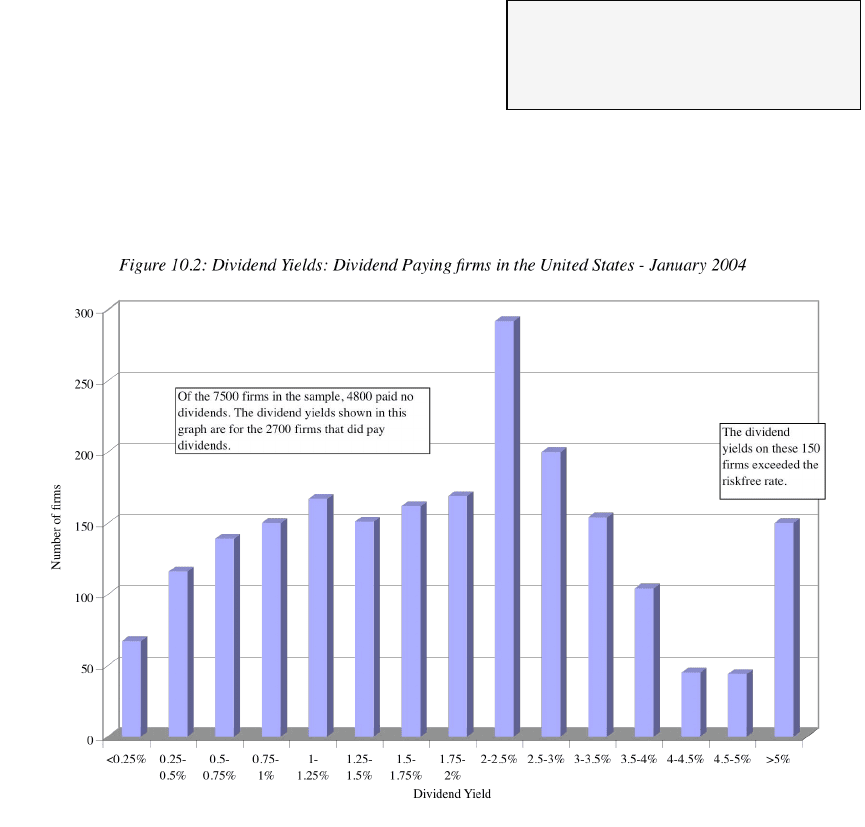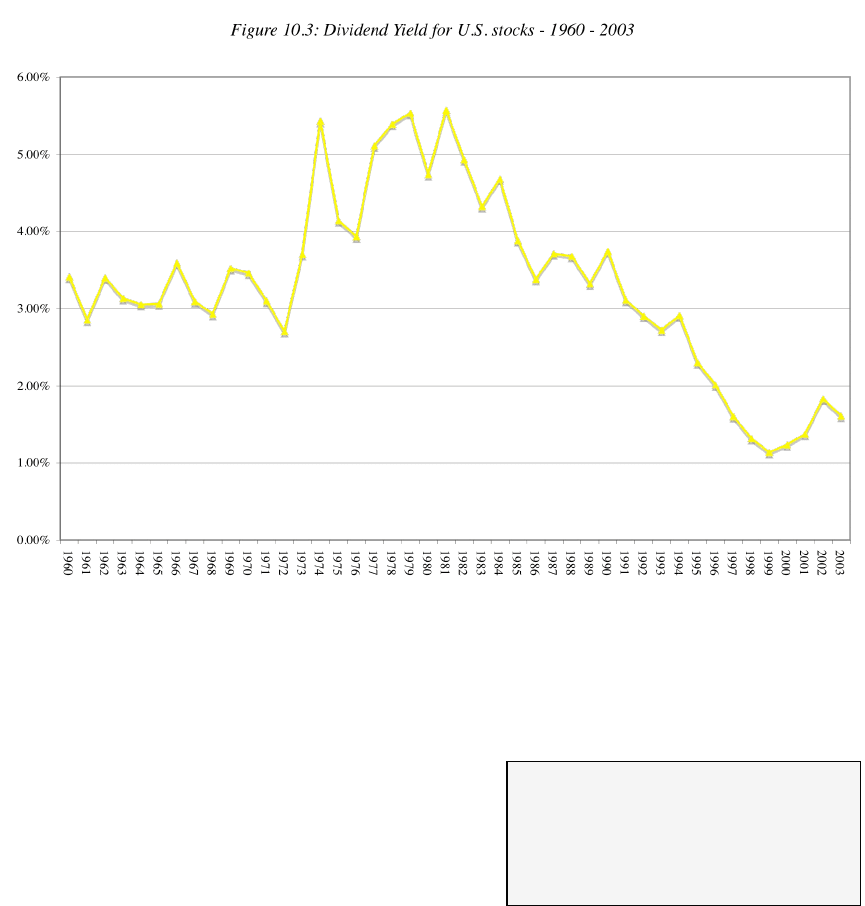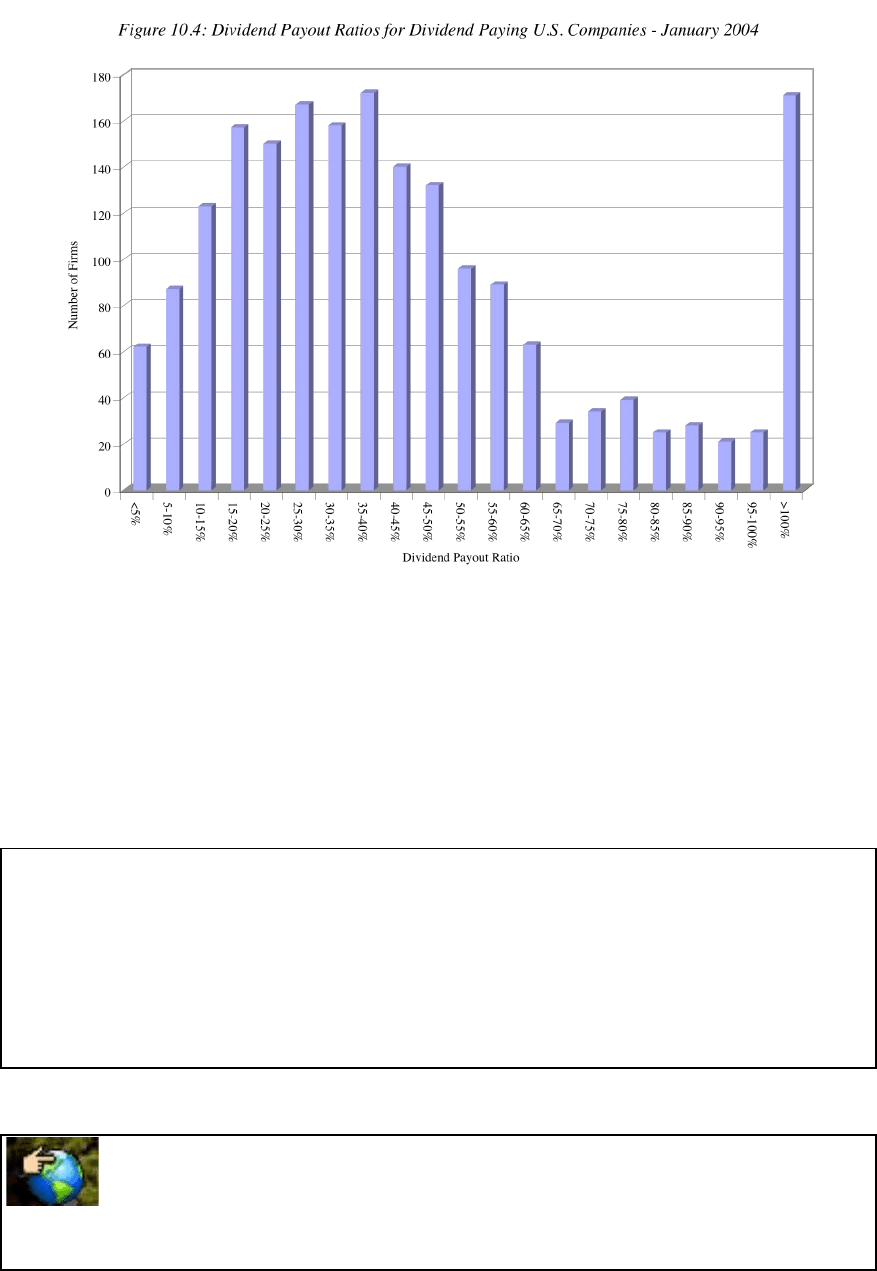Damodaran A. Applied corporate finance
Подождите немного. Документ загружается.

64
64
13. You are trying to decide whether the debt structure that Bethlehem Steel has currently
is appropriate, given its assets. You regress changes in firm value against changes in
interest rates, and arrive at the following equation –
Change in Firm Value = 0.20% - 6.33 (Change in Interest Rates)
a. If Bethlehem Steel has primarily short term debt outstanding, with a maturity of 1 year,
would you deem it appropriate?
b. Why might Bethlehem Steel be inclined to use short term debt to finance longer term
assets?
14. Railroad companies in the United States tend to have long term, fixed rate, dollar
denominated debt. Explain why.
15. The following table summarizes the results of regressing changes in firm value
against changes in interest rates for six major footwear companies –
Change in Firm Value = a + b (Change in Long Term Interest Rates)
Company Intercept (a) Slope Coefficient (b)
LA Gear -0.07 -4.74
Nike 0.05 - 11.03
Stride Rite 0.01 -8.08
Timberland 0.06 -22.50
Reebok 0.04 - 4.79
Wolverine 0.06 -2.42
a. How would you use these results to design debt for each of these companies?
b. How would you explain the wide variation across companies? Would you use the
average across the companies in any way?
65
65
16. You have run a series of regressions of firm value changes at Motorola, the
semiconductor company, against changes in a number of macro-economic variables. The
results are summarized below –
Change in Firm Value = 0.05 - 3.87 (Change in Long Term Interest Rate)
Change in Firm Value = 0.02 + 5.76 (Change in Real GNP)
Change in Firm Value = 0.04 - 2.59 (Inflation Rate)
Change in Firm Value = 0.05 - 3.40 ($/DM)
a. Based upon these regressions, how would you design Motorola’s financing?
b. Motorola, like all semiconductor companies, is sensitive to the health of high
technology companies. Is there any special feature you can add to the debt to reflect this
dependence?

1
1
CHAPTER 10
DIVIDEND POLICY
At the end of each year, every publicly traded company has to decide whether to
return cash to its stockholders and, if yes, how much in the form of dividends. The owner
of a private company has to make a similar decision about how much cash he plans to
withdraw from the business, and how much to reinvest. This is the dividend decision, and
we begin this chapter by providing some background on three aspects of dividend policy.
One is a purely procedural question about how dividends are set and paid out to
stockholders. The second is an examination of widely used measures of how much a firm
pays in the dividends. The third is an empirical examination of some patterns that firms
follow in dividend policy.
Having laid this groundwork, we look at three schools of thought on dividend
policy. The dividend irrelevance school believes that dividends do not really matter,
because they do not affect firm value. This argument is based upon two assumptions. The
first is that there is no tax disadvantage to an investor to receiving dividends, and the
second is that firms can raise funds in capital markets for new investments without
bearing significant issuance costs. The proponents of the second school feel that
dividends are bad for the average stockholder because of the tax disadvantage they create,
which results in lower value. Finally, there are those in a third group who argue that
dividends are clearly good because stockholders (or at least some of them) like them.
Although dividends have traditionally been considered the primary approach for
publicly traded firms to return cash or assets to their stockholders, they comprise only
one of many ways available to the firm to accomplish this objective. In particular, firms
can return cash to stockholders through equity repurchases, where the cash is used to buy
back outstanding stock in the firm and reduce the number of shares outstanding. In
addition, firms can return some of their assets to their stockholders in the form of spin
offs and split offs. This chapter will focus on dividends specifically, but the next chapter
will examine the other alternatives available to firms, and how to choose between
dividends and these alternatives.

2
2
Background on Dividend Policy
In this section, we consider three issues. First, how do firms decide how much to
pay in dividends, and how do those dividends actually get paid to the stockholders? We
next consider two widely used measures of how much a firm pays in dividends, the
dividend payout ratio and the dividend yield. We follow up by looking at some empirical
evidence on firm behavior in setting and changing dividends.
The Dividend Process
Firms in the United States generally pay dividends every quarter, whereas firms in
other countries typically pay dividends on a semi-annual or annual basis. Let us look at
the time line associated with dividend payment and define different types of dividends.
The Dividend Payment Time Line
Dividends in publicly traded firms are usually set by the board of directors and
paid out to stockholders a few weeks later. There are several key dates between the time
the board declares the dividend until the dividend is actually paid.
• The first date of note is the dividend declaration date, the date on which the board
of directors declares the dollar dividend that will be paid for that quarter (or period).
This date is important because by announcing its intent to increase, decrease, or
maintain dividend, the firm conveys information to financial markets. Thus, if the
firm changes its dividends, this is the date on which the market reaction to the change
is most likely to occur.
• The next date of note is the ex-dividend date, at which time investors have to have
bought the stock in order to receive the dividend. Since the dividend is not received
by investors buying stock after the ex-dividend date, the stock price will generally fall
on that day to reflect that loss.
• At the close of the business a few days after the ex-dividend date, the company closes
its stock transfer books and makes up a list of the shareholders to date on the holder-
of-record date. These shareholders will receive the dividends. There should be
generally be no price effect on this date.
• The final step involves mailing out the dividend checks on the dividend payment
date. In most cases, the payment date is two to three weeks after the holder-of-record

3
3
date. While stockholders may view this as an important day, there should be no price
impact on this day either.
Figure 10.1 presents these key dates on a time line.
Figure 10.1: The Dividend Time Line
Board of Directors
announces quarterly
dividend per share
Stock has to be bought
by this date for investor
to receive dividends
Company closes
books and records
owners of stock
Dividend is
paid to
stockholders
Announcement Date
Ex-Dividend day
Holder-of-record day
Payment day
2 to 3 weeks
2-3 days
2-3 weeks
Types of Dividends
There are several ways to classify dividends. First, dividends can be paid in cash
or as additional stock. Stock dividends increase the number of shares outstanding and
generally reduce the price per share. Second, the dividend can be a regular dividend,
which is paid at regular intervals (quarterly, semi-annually, or annually), or a special
dividend, which is paid in addition to the regular dividend. Most U.S. firms pay regular
dividends every quarter; special dividends are paid at irregular intervals. Finally, firms
sometimes pay dividends that are in excess of the retained earnings they show on their
books. These are called liquidating dividends and are viewed by the Internal Revenue
Service as return on capital rather than ordinary income. Consequently, they can have
different tax consequences for investors.
Measures of Dividend Policy
We generally measure the dividends paid by a firm using one of two measures.
The first is the dividend yield, which relates the dividend paid to the price of the stock:
Dividend Yield = Annual Dividends per share / Price per share
The dividend yield is significant because it provides a measure of that component of the
total return that comes from dividends, with the balance coming from price appreciation.
Expected Return on Stock = Dividend Yield + Price Appreciation
Some investors also use the dividend yield as a measure of risk and as an investment
screen, i.e., they invest in stocks with high dividend yields. Studies indicate that stocks

4
4
with high dividend yields earn excess returns, after adjusting for market performance and
risk.
Figure 10.2 tracks dividend yields on the
2700 listed stocks in the United States that paid
dividends on the major exchanges in January 2004. Note, though, that 4800 firms out of
the total sample of 7500 firms did not pay dividends. Strictly speaking, the median
dividend yield for a stock in the United States is zero.
a
Estimated using Value Line data on companies in January 2004
The median dividend yield among dividend paying stocks is 1.80%, and the average
dividend yield of 2/12% is low by historical standards, as evidenced by Figure 10.3,
which plots average dividend yields by year from 1960 to 2003.
Dividend Yield: This is the dollar
dividend per share divided by the current
price per share.

5
5
a
Estimated using S&P 500 data from 1960 to 2003; Source is Bloomberg.
The second widely used measure of dividend policy is the dividend payout ratio,
which relates dividends paid to the earnings of the firm.
Dividend Payout Ratio = Dividends / Earnings
The payout ratio is used in a number of different
settings. It is used in valuation as a way of
estimating dividends in future periods, since most
analysts estimate growth in earnings rather than
dividends. Second, the retention ratio –– the proportion of the earnings reinvested in the
firm (Retention Ratio = 1 -Dividend Payout Ratio) –– is useful in estimating future
growth in earnings; firms with high retention ratios (low payout ratios) generally have
higher growth rates in earnings than do firms with lower retention ratios (higher payout
ratios). Third, the dividend payout ratio tends to follow the life cycle of the firm, starting
at zero when the firm is in high growth and gradually increasing as the firm matures and
its growth prospects decrease. Figure 10.4 graphs the dividend payout ratios of U.S. firms
that paid dividends in January 2004.
Dividend Payout: This is the dividend
paid as a percent of the net income of the
firm. If the earnings are negative, it is not
meaningful.

6
6
a
Estimated using Value Line data on companies in January 2004
The payout ratios greater than 100% represent firms that paid out more than their
earnings as dividends. The median dividend payout ratio in January 2004 among
dividend paying stocks, was about 30 % while the average payout ratio was
approximately 35%.
10.1. ☞: Dividends that Exceed Earnings
Companies should never pay out more than 100% of their earnings as dividends.
a. True
b. False
Explain.
divUS.xls: There is a dataset on the web that summarizes dividend yields and
payout ratios for U.S. companies from 1960 to the present.

7
7
Empirical Evidence on Dividend Policy
We observe several interesting patterns when we look at the dividend policies of
firms in the United States in the last 50 years. First, dividends tend to lag behind
earnings; that is, increases in earnings are followed by increases in dividends, and
decreases in earnings sometimes by dividend cuts. Second, dividends are “sticky”
because firms are typically reluctant to change dividends; in particular, firms avoid
cutting dividends even when earnings drop. Third, dividends tend to follow a much
smoother path than do earnings. Finally, there are distinct differences in dividend policy
over the life cycle of a firm, resulting from changes in growth rates, cash flows, and
project availability.
Dividends Tend To Follow Earnings
It should not come as a surprise that earnings and dividends are positively
correlated over time, because dividends are paid out of earnings. Figure 10.5 shows the
movement in both earnings and dividends between 1960 and 1998.
a
Estimated from Compustat annual database

8
8
Notice two trends in this graph. First, dividend changes trail earnings changes over time.
Second, the dividend series is much smoother than is the earnings series.
In the 1950s, John Lintner studied the way firms
set dividends and noted three consistent patterns.
1
First,
firms set target dividend payout ratios, by deciding on the
fraction of earnings they are willing to pay out as
dividends in the long term. Second, they change
dividends to match long-term and sustainable shifts in earnings, but they increase
dividends only if they feel they can maintain these higher dividends. Because firms avoid
cutting dividends, dividends lag earnings. Finally, managers are much more concerned
about changes in dividends than about levels of dividends.
Fama and Babiak identified a lag between earnings and dividends, by regressing
changes in dividends against changes in earnings in both current and prior periods
2
. They
confirmed Lintner’s findings that dividend changes tend to follow earnings changes.
10.2. ☞: Determinants of Dividend Lag
Which of the following types of firms is likely to wait least after earnings go up before
increasing dividends?
a. A cyclical firm, whose earnings have surged because of an economic boom
b. A pharmaceutical firm whose earnings have increased steadily over the last 5 years,
due to a successful new drug.
c. A personal computer manufacturer, whose latest laptop’s success has translated into a
surge in earnings
Explain.
Dividends Are Sticky
Firms generally do not change their dollar dividends frequently. This reluctance to
change dividends, which results in ‘sticky dividends,’ is rooted in several factors. One is
1
Lintner, J., Distribution of Income of Corporations among Dividends, Retained Earnings and Taxes,
American Economic Review, 1956, v46, 97-113.
2
Fama, E. F. and H. Babiak. Dividend Policy: An Empirical Analysis, Journal of the American Statistical
Association, 1968, v63(324), 1132-1161.
Target Dividend Payout Ratio:
This is the desired proportion of
earnings that a firm wants to pay
out in dividends.
